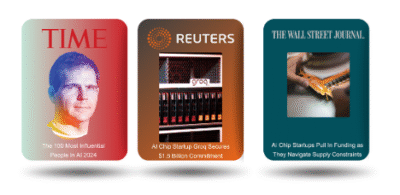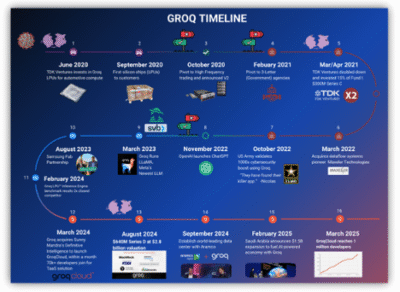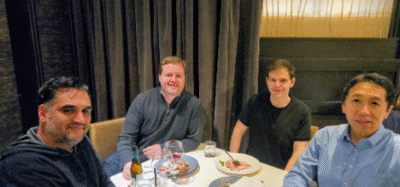Nicolas Sauvage | TDK Ventures
In 2020, I led TDK Ventures’ moonshot investment in Groq and doubled our stake to 15% of our first fund — decisions I made with conviction despite internal skepticism. Just today, Groq announced a $6.9B valuation, underscoring how far the company has come. This is the inside story of conviction and pivots, why Groq’s LPU + GroqCloud stack now points to a capital-efficient path to scaled inference, and what we’re watching next.
Groq in 2020: A Moonshot Bet on AI Compute
Just over five years ago, in July 2020, I led TDK Ventures’ investment in Groq, a decision, and truly a journey, that feels both extraordinary and humbling to reflect on today. At TDK Ventures, every investment is deeply personal. Each decision to partner with a startup rests on the conviction of a single investment lead, who must champion the case to the rest of the team and withstand the full rigor of our Devil’s Advocate practice, where colleagues challenge every possible reason not to invest. For Groq, that champion was me. It was only my third investment as a venture capitalist, and I was determined to see what others doubted.
At the time, I projected Groq had a 90% chance of crossing $2 billion in valuation, and even a 50% chance of exceeding $5 billion. I was incredibly bullish, and — as I can admit now — a bit naive. Those numbers have indeed become reality, though not always for the reasons I once imagined. My choice bore the hallmarks of both bold conviction and rookie overconfidence, shaped more by intuition and the “art” of investing than by the seasoned judgment I have developed since. What I thought would be a straight-line climb has, in truth, been a winding road of pivots, near-death moments, and resilience.
That is why, while I’m grateful the decision proved right, I can’t claim full credit. The real story lies in Jonathan Ross and his team’s relentless pursuit of a first-principles vision, a vision that reshaped AI compute and validated the conviction I placed in them, even when others (inside and outside TDK Ventures) were not convinced.
A few of the many well-earned recognitions of Groq in the past year
In 2020, Groq’s focus was on delivering a superior compiler and its first taped-out chipset (in their first attempt, no less), the then-called Intelligence Processing Unit (IPU). The 2020 market was intense, crowded, and filled with skepticism about whether Groq could meaningfully differentiate and deliver outstanding returns. Some of this skepticism even came from within TDK Ventures — and not just prior to our investment, but as recently as last year.
“I am glad you are bullish Nicolas, but… we are also hearing that Groq hasn’t found their product market fit and struggling to raise money. They need to hit a $10Bn valuation for us to return the fund, and with their revenue they need about 10 miracles to reach that in this market.” — TDK Ventures internal feedback, Feb 25, 2024
Thankfully, my early conviction for Groq is winning out, even though it wasn’t an entirely popular decision. Admittedly, my position as President likely gave me more leeway than others may have had. The candor of my colleagues’ doubts underscored just how serious and justified their concerns were — yet I chose not to waver.
Not only did TDK Ventures move forward with investing, but less than a year later, we doubled down and broke conventional wisdom by committing 15% of our Fund 1 to Groq– far above the typical practice to not allocate more than 10% of a fund to any single company.
Sidebar for investors on portfolio construction
1) Concentrated conviction can be rational, when paired with structured dissent (Devil’s Advocate) and staged validation gates.
2) Double-down criteria we used: founder quality signal ↑, technical defensibility ↑, strategic distribution options ↑, early customer pull ↑.
3) Risk we accepted: market timing & PMF.
4) Risk we refused: team quality and architecture mismatch.
5) Process matters: single-lead ownership + firm-wide challenge + explicit pre-mortem on ways this will fail.
It’s this early (and sustained) conviction, both my own at TDK Ventures and Jonathan Ross’ as founder and CEO of Groq, that I want to explore in this article. Since their founding, Groq has weathered years of doubt and uncertainty to become the nearly $7 billion valuation they earned today. This was never just about numbers, but a vision to redefine AI compute — a vision Jonathan laid out in our very first conversation on June 5, 2020.
Jonathan Ross: A Vision Rooted in First Principles
Of course, my conviction wasn’t only about optimistic financial outcomes, it was about Jonathan’s vision. In my notes from that first meeting with Jonathan, that I had shared on LinkedIn:
“This feels like investing in Nvidia or Qualcomm at the pre-revenue stage. With a top-tier team, a production-ready chip delivered in record time, order-of-magnitude performance advantages, and a go-to-market strategy aligned with TDK’s priorities in mobility and AI, Groq is worth the risk.”
What struck me most during that first call — and what sparked my immediate conviction — was Jonathan’s first principles-based bet, and vision, for the future. It was a simple hypothesis: We are going to need to run very large AI models, and inference will become the bottleneck.
From that premise came Groq’s mission — to drive the cost of inference toward zero through their novel approach to chip design and on-chip memory. Their chipset was both more energy efficient (critical for sustainability at deployment scale) and faster than industry-standard GPU solutions for inference. Jonathan saw this as a way to democratize AI access –an essential step to ensuring human agency in the AI era.
His insight into memory design was compelling in its own right. While Moore’s law has seen the doubling of transistors (i.e., compute capability on a chip) every 18–24 months, AI performance was improving much faster because the number of chips used was also multiplying. This shift opened the door to an alternative approach: instead of focusing solely on improving per-chip performance and relying on high(er) latency external memory, leverage and innovate on-chip memory.
Jonathan’s vision resonated deeply with my own deep exploration in this space and aligned closely with passions I had been pursuing for years. If I needed further validation, I got it days later from a reference call with my former CEO and mentor, Behrooz Abdi:
“With the rise of autonomous vehicles, sensors, and 5G, big data is exploding, but most remains trapped at the edge. As Moore’s Law slows, AI hardware like Groq’s can unlock data centers and bring intelligent decision-making to the edge. TDK’s expertise in sensors and energy management makes this a strategic fit.” — Behrooz Abdi, former InvenSense CEO — June 11, 2020
By now, we know that Jonathan was right in his hypothesis. Inference is becoming a critical bottleneck with the advent of large LLMs — though in 2020, he was ahead of the market. That’s the gift and curse of first principles thinking — it’s a matter of when and not if. Even with technical excellence, Groq was just beginning to find product-market fit (one which we’ll explore in greater detail shortly).
As Jonathan put it himself in an interview:
“It’s not enough to ride the wave, but rather position yourself for the wave before it hits. Don’t compete, but find an unsolved customer problem and solve it.”
In that respect, Groq’s timing was right on. They were positioning for the wave, even if neither Jonathan nor myself knew exactly how it would break. My belief back then was less about predicting the future and more about trusting Jonathan and his team to create it.
Groq & TDK Ventures: Parallel Motivations
Some of my early conviction for Groq may have stemmed from recognizing a kindred spirit in Jonathan — and seeing parallels with my own journey starting TDK Ventures. TDK Ventures was born from the Silicon Valley ethos of InvenSense, acquired in 2017, where I worked under Behrooz Abdi. That startup DNA, combined with Behrooz’s insights and my own bias for first-principles thinking, primed me to see Groq’s potential as a game-changer.
Jonathan’s vision was bold and unyielding, but many dismissed it as unlikely or even impossible — much like my own had been when pitching the TDK Ventures concept to TDK’s leadership. His ability to articulate complex problems with clarity mirrored the founders-first approach I aspired to bring to venture capital.
Even after investing, perhaps my greatest insight into Jonathan — and into what Groq’s future might hold — came in the most unlikely of settings: my garden, during the height of COVID-19 in the summer of 2021. We spoke for eight hours — roadmap, talent acquisition and density, and even first-principles takes on broader questions. Despite market doubts and the challenging landscape, I knew Groq would win big, or die trying.
Fast forward to 2025, and Groq stands as an ‘overnight success’ — one that was, in truth, nine years in the making. With a $6.9 billion valuation, about 25% of TDK’s market cap as of today, Groq is on a trajectory that, if sustained, could overtake TDK within a few years. Their meteoric rise highlights the power of persistence, bold vision, and the right partners at the right time.
Partnership for us has always meant more than capital. We aim to be an extension of our founders’ teams — helping them solve real challenges, accelerate development, and unlock advantages that competitors can’t easily replicate.
For Groq, this came to life through what we call “TDK Goodness” — the unique advantage of unlocking TDK’s global resources to accelerate our startups. Our team helped source and qualify more than 50 TDK components per board to ensure supply stability and reliability, and we brought TDK’s power-systems experts together with Groq’s engineers to co-develop a power-management roadmap — an equal-win plan that enabled first-to-market superior power solutions while de-risking future product generations.
These kinds of collaborations don’t just accelerate startups — they highlight how hard-won breakthroughs really are. It is a powerful reminder of the difficulties of true progress, and a reminder to us investors perhaps that intuition and conviction, balanced with rigorous analysis, are vital in venture capital, a theme I have written about previously. (See “From Founders to Impact Scalers: How TDK Ventures Drives Innovation Through Corporate Venture Capital”).
The Evolution of Groq: Journey to Product-Market Fit
Groq’s path to product-market fit since 2020 has been anything but linear. Back then, their vision centered on the IPU, the chipset designed to tackle the data deluge from AI and related data centers — with an initial focus on automotive applications. The IPU’s novel architecture promised superior responsiveness, reduced latency, and energy efficiency — crucial for addressing the massive CO2 costs of Big Data. They delivered a revolutionary performance — much of which I detailed in our original Why We Invested in Groq article.
I saw the IPU (and later appropriately renamed Language Processing Unit, or LPU) as a perfect fit for TDK Ventures’ focus on AI, 5G, and clean technology. To me, Groq was poised to become a “King of the Hill” in AI hardware, and as you now know, I was undeterred by a crowded market or the risks of scaling (even during a global pandemic).
What followed, however, was a grueling demonstration of creativity and resilience. Moving away from their initial automotive emphasis, since 2020, they have pivoted three times, with a few more existential threats added along the journey for good measure — any of which could have ended their story. Jonathan Ross’s leadership and the team’s tenacity defined their ability to navigate these storms.
Some of the company’s most defining moments include:
- October 2020 — Pivot to high-frequency trading applications: leveraging predictable low-latency strengths for financial markets. It was a bold shift, showing their ability to adapt to where their technology could make the biggest impact.
- February 2021 — Pivot to U.S. government applications: particularly for three-letter agencies requiring secure, high-performance computing. This move leveraged the IPU’s unique capabilities to meet stringent, mission-critical demands.
- Winter 2022 — Decisive pivot on Meta’s large language model LLaMA: coining the term “Language Processing Unit” (LPU), a name that captured their optimized role in AI inference. This shift positioned them at the heart of the growing LLM market, aligning perfectly with an emerging industry need.
Groq’s timeline and rocky path to product/market fit
By 2023, the LPU focus had found its moment, and with the refocus on running AI and LLMs, Groq had found just the right market fit — finally starting to feel the wave pick up following years of building and positioning. Shortly thereafter, a Samsung fabrication partnership (August 2023) and the acquisition of Definitive Intelligence (March 2024) fueled the launch of GroqCloud, expanding from chip sales to a scalable AI infrastructure business model, a business model innovation one could argue as a fourth pivot. Funding remained tight until a $640 million Series D, led by BlackRock, propelled GroqCloud to now over 2 million developers and solidified global LPU deployment — where momentum began to soar beyond where anyone could doubt.
Navigating these near-death moments wasn’t luck — it was a masterclass in clarity, tenacity, and execution under pressure. Each pivot refined their vision, transforming them into a leader in AI infrastructure. Groq’s story proves that the “jockey” — Jonathan and his team — matters as much as, if not more than, the “horse” — the technology. Their resilience has not only validated our early bet but has positioned them to redefine how AI is powered, a journey I feel privileged to have supported early on.
The Groq of Today
Today, I see Groq’s leadership resting on three pillars:
- LPU foundational technology— purpose-built for inference speed, deterministic latency and efficiency.
- Fabrication partnershipwith GlobalFoundries & Samsung — for domestic, responsive and scalable chipset production.
- GroqCloud — a “token-as-a-service” platform — metering inference by tokens/sec with incomparable latency.
Upon these pillars, the team has moved beyond providing a tech solution and is building an entire ecosystem — delivering on the promise to democratize access to compute, just as Jonathan outlined all those years ago.
The complete AI infrastructure ecosystem provided by Groq
Compared to GPUs, LPUs are not competitors but complements: GPUs excel at model training, LPUs at inference. Groq’s rapid scaling has been made possible through key partnerships and a unique revenue-sharing type business model whereby manufacturing greats like Samsung and GlobalFoundries are empowered to provide crucial infrastructure and supply. At its core, this decouples Groq’s production capability from capital requirements and instead is only limited by the speed of chip production.
As their final pillar — Groq’s mass deployment of AI infrastructure and resources, and their acquisition of Definitive Intelligence, spurred the deployment of GroqCloud using Groq hardware for Token-as-a-Service (TaaS). This reached 2 million developers in August 2025. Hardware available for use, either physically or virtually, anywhere in the world.
This growth has already translated into real-world impact — beginning with a 2024 partnership with Aramco’s AI datacenter, with a $1.5 billion revenue attached to it (with shared profits to fabrication partners) as part of Saudi Arabia’s drive toward an AI-powered economy. Needless to say, Groq must continue securing marquee customers to grow and diversify revenue and cement its path toward becoming an iconic company.
Conviction for the Road Ahead: A Sustainable, Democratized AI Future
Groq’s impact is undeniable. Their trajectory — resilience, pivots, and strategic wins — reflects the power of a first principles vision backed by fierce execution.
Jonathan and his team have overcome enormous adversity and fought for their vision every step of the way. I’m humbled to have witnessed some of their efforts firsthand, yet, as staggering as their numbers are now, I’m (still) convinced their journey is just getting started. As my mentor Paul Holland once put it:
“When startups lift off, they really lift off.”
Groq’s trajectory is living proof of that, turning a “crazy” moonshot into a cornerstone of AI infrastructure. The demand for scalable, efficient AI compute is surging, and Groq’s LPUs are built to meet that need now and at scale.
As AI adoption accelerates, Groq’s role as an equalizer — making inference fast, affordable, and sustainable — will only grow more critical. They are shaping a future where innovation elevates everyone, from startups building real-time healthcare diagnostics to teams tackling climate modeling.
From the perspective of synergy with TDK, Groq continues to embody our mission to drive a sustainable future through hard-tech innovation, bridging AI’s digital transformation with the energy transformation of efficient compute. Their efficiency aligns with our clean-tech focus, alongside investments in fusion (Type One Energy), energy distribution (SPAN), and advanced energy storage solutions (Peak Energy).
On our end at TDK Ventures, I know I’ll continue to do everything I can to support and aid Jonathan and the entire Groq team along their journey. Every year, we ask for feedback on how we have or can better support each of our portfolio companies, and one year Jonathan humbled us with the following compliment:
TDK Ventures: “What was the best value that TDK Ventures brought to you?”
Jonathan: “Specifically, your ability to clearly articulate our value proposition. I’ve heard feedback from our other investors and our board members about how well you speak about us… Being able to help other people think about why they’d invest.”
I’ll never forget a dinner where I introduced Jonathan Ross and Sunny Madra to AI luminary Andrew Ng. As we wrapped up, Andrew turned to Jonathan and said, “I’m glad we met today before you’re too famous.” That moment was electric — one titan recognizing another in the making, and yet another validation of the unstoppable momentum behind Jonathan’s first-principles approach and his relentless drive to democratize AI.
A dinner to remember, April 2024
Groq’s story is far from over, and I’m honored to be along for the ride.
If you’re building the next infrastructure layer in AI compute and connectivity, energy systems, advanced materials, and a first-principles path is pulling you forward — reach out.







